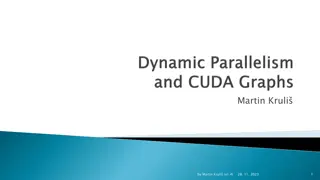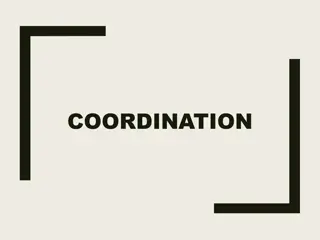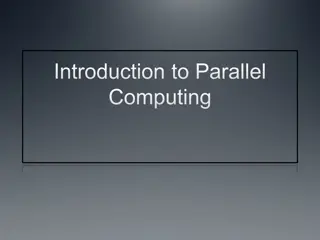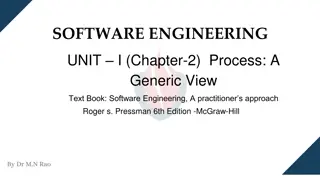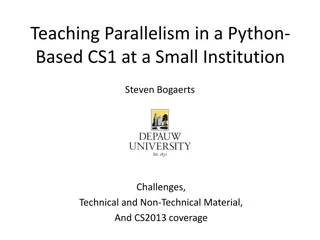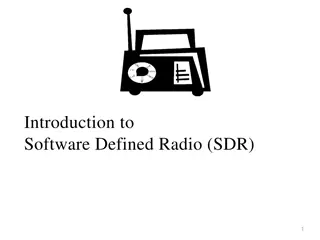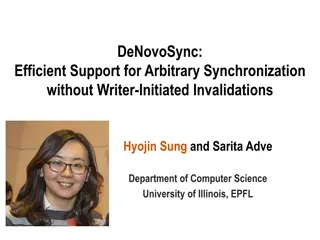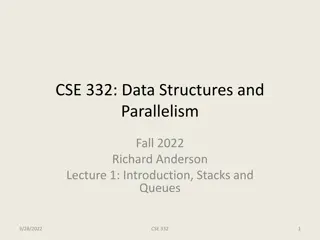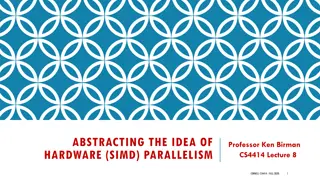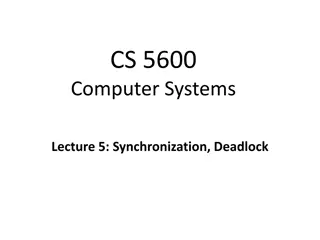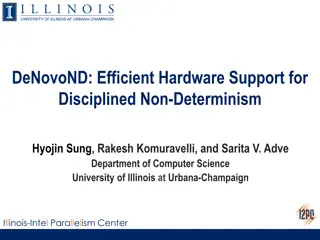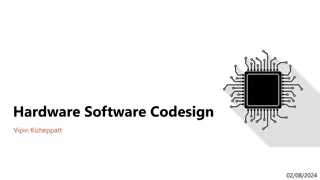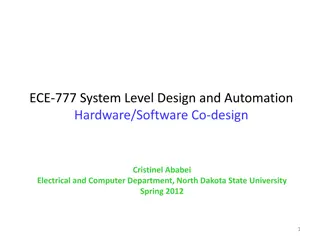Rethinking Hardware and Software for Disciplined Parallelism
Exploring the challenges in popular parallel languages and the mismatch between hardware and software evolution. The Java Memory Model, data races, and unresolved bugs highlight the complexity and safety concerns in building parallel models. Should we banish shared-memory to address these issues?
Download Presentation

Please find below an Image/Link to download the presentation.
The content on the website is provided AS IS for your information and personal use only. It may not be sold, licensed, or shared on other websites without obtaining consent from the author.If you encounter any issues during the download, it is possible that the publisher has removed the file from their server.
You are allowed to download the files provided on this website for personal or commercial use, subject to the condition that they are used lawfully. All files are the property of their respective owners.
The content on the website is provided AS IS for your information and personal use only. It may not be sold, licensed, or shared on other websites without obtaining consent from the author.
E N D
Presentation Transcript
Rethinking Hardware and Software for Disciplined Parallelism Sarita V. Adve University of Illinois sadve@illinois.edu
Sequential CS 101 Java
Parallel CS 101 Threads Java
Parallel CS 101 Threads Java Data races
Parallel CS 101 Threads Java Data races Non-determinism
Parallel CS 101 Threads Java Memory Model Non-determinism Data races General-purpose parallel models are complex, abandon decades of sequential programming advances Safety, modularity, composability, maintainability,
The Problem Popular parallel languages are fundamentally broken
The Problem Theorem: Popular parallel languages are fundamentally broken Proof: See the Java Memory Model (+ unresolved bug)
The Problem Theorem: Popular parallel languages are fundamentally broken Proof: See the Java Memory Model (+ unresolved bug) Memory consistency model = what values can a read return? 20+ years of research finally led to convergence But extremely complex * Dealing with data races is very hard * Mismatch between hardware and software evolution We are building on a foundation where even legal values for reads are complex to specify
The Problem Theorem: Current parallel languages are fundamentally broken Proof: See the Java Memory Model (+ unresolved bug) Memory model = what values can a read will return? 20+ years of research finally led to convergence Sequential consistency for data-race-free programs is minimal Java added MUCH complexity for safety/security * Minimal (complex) semantics for data races, but unresolved bug C++, C added complexity for experts due to h/w s/w mismatch * Independent h/w s/w evolution resulted in painful consequences Should we continue building on a foundation that can t even specify legal values for reads? Banish shared-memory?
The Problem Theorem: Current parallel languages are fundamentally broken Proof: See the Java Memory Model (+ unresolved bug) Memory model = what values can a read will return? 20+ years of research finally led to convergence Sequential consistency for data-race-free programs is minimal Java added MUCH complexity for safety/security * Minimal (complex) semantics for data races, but unresolved bug C++, C added complexity for experts due to h/w s/w mismatch * Independent h/w s/w evolution resulted in painful consequences Should we continue building on a foundation that can t even specify legal values for reads? Banish wild shared-memory!
The Opportunity Need disciplined shared-memory parallel languages Banish data races by design Provide determinism by default Support only explicit and controlled non-determinism Explicit side effects (sharing behavior, granularity, ) ??? Discipline is enforced Much momentum from software community What does this have to do with hardware?
The Opportunity Memory model = core of parallel hardware/software interface Today s hardware designed for wild shared memory Cache coherence, communication architecture, scheduling, Inefficient in performance, power, resilience, complexity, Claim: Disciplined interface E.g., race-free s/w race-free (MUCH SIMPLER) coherence protocols E.g., explicit sharing behavior and granularity efficient communication, data layout, cache design, h/w simplicity + efficiency
The Approach Software enforces disciplined behavior Software: safe, modular, composable, maintainable, Hardware designed for disciplined software Hardware: simple, scalable, power-efficient, Broad hardware/software research agenda Interface: semantics, mechanisms at all levels, ISA, Rethink hardware: coherence, communication, layout, caches, Help software to abide by interface Fundamental shift in software, hardware But can be done incrementally Memory models convergence from similar process But this time let s co-evolve h/w, s/w



